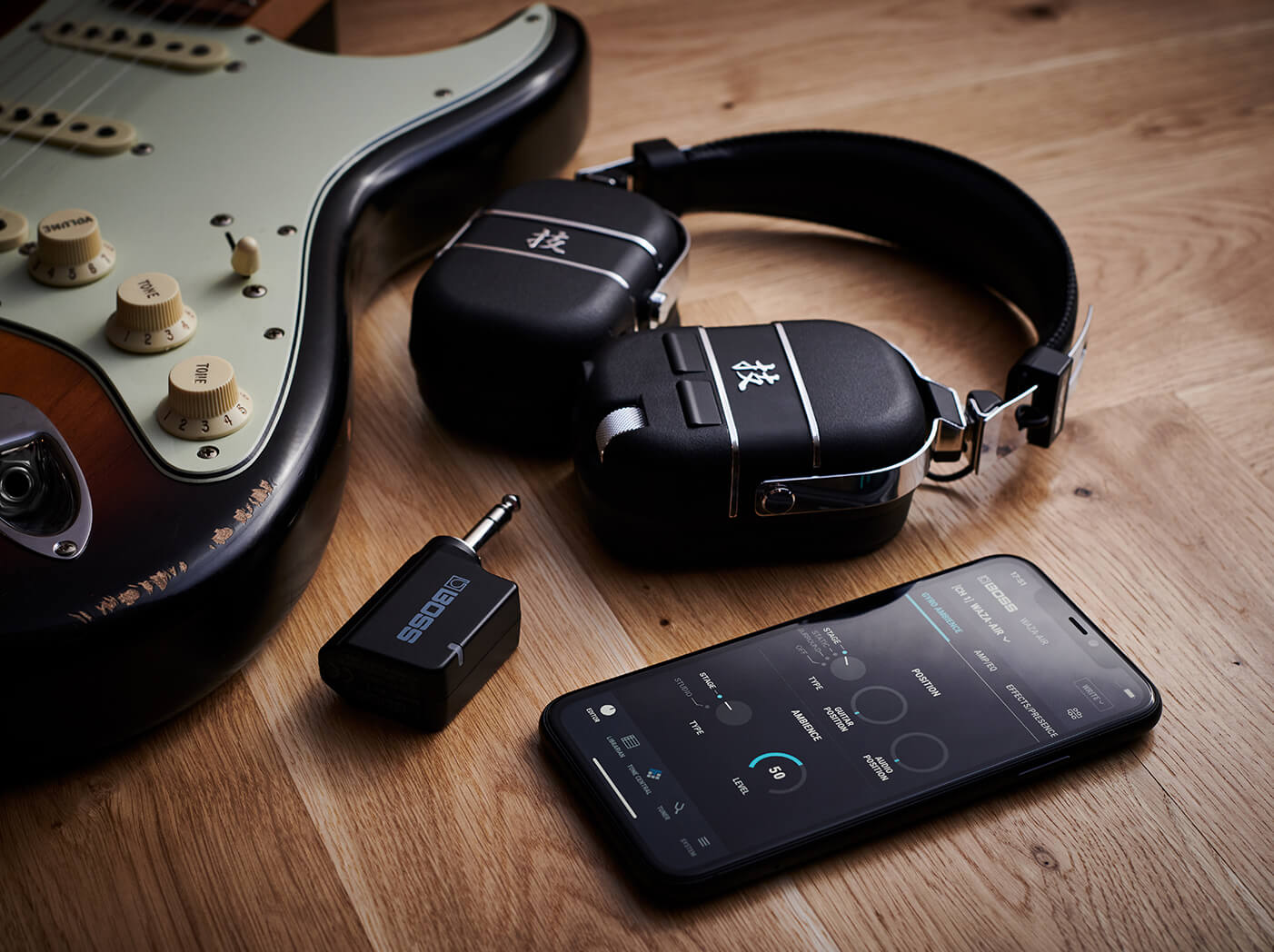What guitar brands can learn from big tech in 2021 and beyond
The times they are a-changing so quickly it hurts, but guitar technology isn’t necessarily changing with them. Is it time for the people making our gear to start paying closer attention to what’s going on outside the musical bubble?

Image: Getty Images
We’re a tough crowd, us guitar players: always demanding new toys, then complaining that they don’t sound exactly the same as the old toys. But technology can never stand still – a fact that will be vividly clear to anyone who’s bought a new smartphone, connected wearable, voice-assistant speaker, hybrid car or interdimensional attack-mechaspider in the past five years.
So what do we really want from the guitar gadgetry of the future… and what can the people designing it learn from the rapidly evolving landscape of mainstream tech?
Rage against the machine heads
Here’s the story of two inventions. The first was a near-miraculous solution to a decades-old problem, launched by a prestigious manufacturer with a huge marketing budget and a loyal international customer base. The other was a more fiddly and less obviously effective device, created by two Lebanese students and funded over the internet. Guess which one did better?
If you’ve sussed that the first company is Gibson, you probably know the answer to that. Having experimented with auto-tuning guitars as far back as 2007, it made the G-Force system available across its six-string range in 2015. For the most part the tech worked pretty well, but the revolution never happened, and by 2019 robotic tuning was totally absent from the Gibson catalogue.
Band Industries launched a Kickstarter campaign for its handheld one-string-at-a-time automatic tuner, the Roadie, in 2013. This little startup company has since won a bunch of awards, sold more than a bunch of units, and unveiled its latest model last May. The Roadie 3 is on sale now, after another crowdfunding campaign that raised almost half a million dollars.
The lesson? Firstly, there’s no such thing as an underdog in the dynamic world of hi-tech innovation. And secondly, a guitar is not a smartphone. The robot tuners flopped because they involved messing with the fabric of the sacred instrument itself; the Roadie system has done better because it can disappear into a bag as soon as you’re done with it. Give us problem-solving gadgets, the market said… but keep your hands off the timber.

Knotting’s gonna stop us now
So, let’s forget about reimagining the guitar itself. Where, then, is there more room for improvement in the life of the modern plank-plucker? There’s one obvious area where we lag behind high-street consumer tech: cables.
Today’s high-end phones don’t even need plugging in to refuel, thanks to the arrival of wireless charging pads; most headphones have ditched the jack for solid, reliable Bluetooth audio; gaming controllers and mice are increasingly relaying their bullet-swerving moves over 2.4GHz. And guitarists? We spend half our time trying not to step on cables, the other half untangling the frickin’ things.
The good news is, the technology to free us from at least some of this snakey annoyance is around already. Big-name guitarists have been using wireless systems on stage for years, of course, but the emergence of simplified setups such as the Mooer Air P10 – two jack-plug dongles, no external boxes and a semi-reasonable price – suggests cable-free strumming is almost ready to jump off the stadium stages and into our bedrooms.
The key here is latency, because even the slightest audible lag between hitting a note and hearing it back is a serious buzzkill. And not in a good way. The Mooer system has a latency of less than 5ms, which is arguably closer to zero than most of us will ever hear (or, just as importantly, feel); assuming this tech continues to get better, smaller and above all cheaper, the days of guitar lead spaghetti really ought to be numbered.
In the meantime, we’d like to see more amp-modelling units with wireless headphone outputs. The capability is certainly there: Boss’s Waza-Air system sends a signal from your guitar to your head via a maze of digital effects in what is effectively no time at all, pointing to a liberated future for silent solo noodling.
Oh, and if you want to imagine an even more liberated future, look up the Noveto SoundBeamer, a device that claims to fire audio directly into your ears with no headphones required, and without disturbing other people in the same room. Impossible, right? It’s due to go on sale in December 2021.

Fuel if you think it’s over
Power cables, however, are a different story. This is surely the golden age of the stompbox, but many of us are using rather a lot of them, and if they’re not running on dirty old PP3 batteries then each one has to be connected in some way to the mains.
Well, not necessarily. You may have come across Pedaltrain’s Volto rechargeable power supplies, which have been on the market since 2013; for more serious performance, the Mission Engineering 529 has five isolated outputs and runs off USB, meaning it can be fuelled by the same kind of portable battery pack used for phones and tablets. See also the Birdcord USB to 9V converter from Songbird FX, a simple solution for powering individual (or daisychained) pedals.
This all feels a bit niche at the moment, but batteries are one of the real boom sectors in tech, and the lithium-ion cells that fuel everything from smartphones to electric cars are improving in terms of both capacity and recharging speed. For fans of traditional pedals, that might simply mean more hours of untethered playing thanks to USB power bricks with epic stamina; but maybe the manufacturers of more advanced digital units could take things a step further, using the next generation of super-efficient batteries to make their products less like PCs and more like iPads.
Imagine this on a near-future Christmas list, then: a multi-effects processor and amp/cab modeller that’s rechargeable, includes a built-in wireless guitar receiver, and has a Bluetooth output for suitably equipped headphones, audio interfaces and even PAs – in other words, a complete rig for gigging, recording and silent practice that has absolutely no cables involved anywhere. If you want to trip over, you’ll have to get longer shoelaces.
Ballad of a thin manual
The key to successful tech in the early 21st century has been simplicity. For the most part, guitar gear makers have cottoned on that, just like iPhone fans, we want to get stuck in with minimal setup and instruction. The next step might appear to be to follow the trend towards ultra-simplified user interfaces involving multi-touch screens, voice control or even in-the-air hand gestures.
Do we want that, though? Touchscreens can be hugely useful for navigating complex devices; but with the notable exceptions of Neural DSP and HeadRush, the makers of digital effects units and modelling amps have made a choice not to go down that route – perhaps because there’s a rewarding musicality to the act of tweaking physical knobs that just can’t be emulated on a screen. Likewise, do you really fancy turning to your amp and saying, “Alexa, turn me up to eleven”?
Here, though, is what Neural boss Doug Castro told us in a video interview for Guitar.com Live in October: “I think we’re almost hitting a saturation point when it comes to signal processing, and I don’t think there are big breakthroughs to achieve in making great guitar sounds. But when it comes to the user experience, that’s where I see the next big wave of new technology for musicians happening – creating user interfaces that make it easier for people to enjoy the experience and explore.”
Whatever Doug’s hinting at there, it’s almost certain to involve building on the systems already being used by smartphones, smartwatches and/or smart speakers. As digital gear gets more and more ambitious, we might need some of that help to find our way around it. Are Neural’s rivals taking note?
Can’t get you out of my headset
If there’s one technological lesson that the whole world learned in 2020, it’s that being in the same room as the people you’re working with isn’t as essential as we used to think. We’re hardly lagging behind here – long-distance musical collaboration is easy when everyone has a home studio and access to Dropbox, not to mention online DAWs such as BandLab – but ensemble playing is a much bigger challenge. Can you imagine trying to have a band practice over Zoom?
But now picture a world, not too far ahead of us, where the home broadband network is much quicker than anything we have now – and couple that with a few years of steady advances in the immersive quality of virtual reality. Today’s consumer VR headsets offer some spectacular experiences, but once we progress to lightweight headsets that make walking around a virtual world feel almost as natural as life in the real one, things could get really interesting for musicians.
As a guitar player, all you’d really need here would be some kind of dongle to connect your instrument’s output to the system – and a mixed-reality headset that would let you see your own real-world fingers in the same 3D space as your virtual band. This could be a backing group of AI avatars, accompanying your six-string heroics in front of a shrieking crowd like the ultimate karaoke machine, or – and this is where you’d really need lightning-fast internet connectivity – real people logged into the same system anywhere in the world. BandLab Live, basically.
Could this be a genuine alternative to playing with a real band, in a real gig venue or rehearsal space, with real tinnitus? Of course not, but it could be a right laugh. And just like everything else we’ve crystal-balled in this feature, it’s only going to happen if we want it to. Simple valve amps, analogue stompboxes and twisty cables aren’t going anywhere just yet; beyond that, the market will decide what floats and what sinks. And we’re a tough crowd, us guitar players.
For more features, click here.
